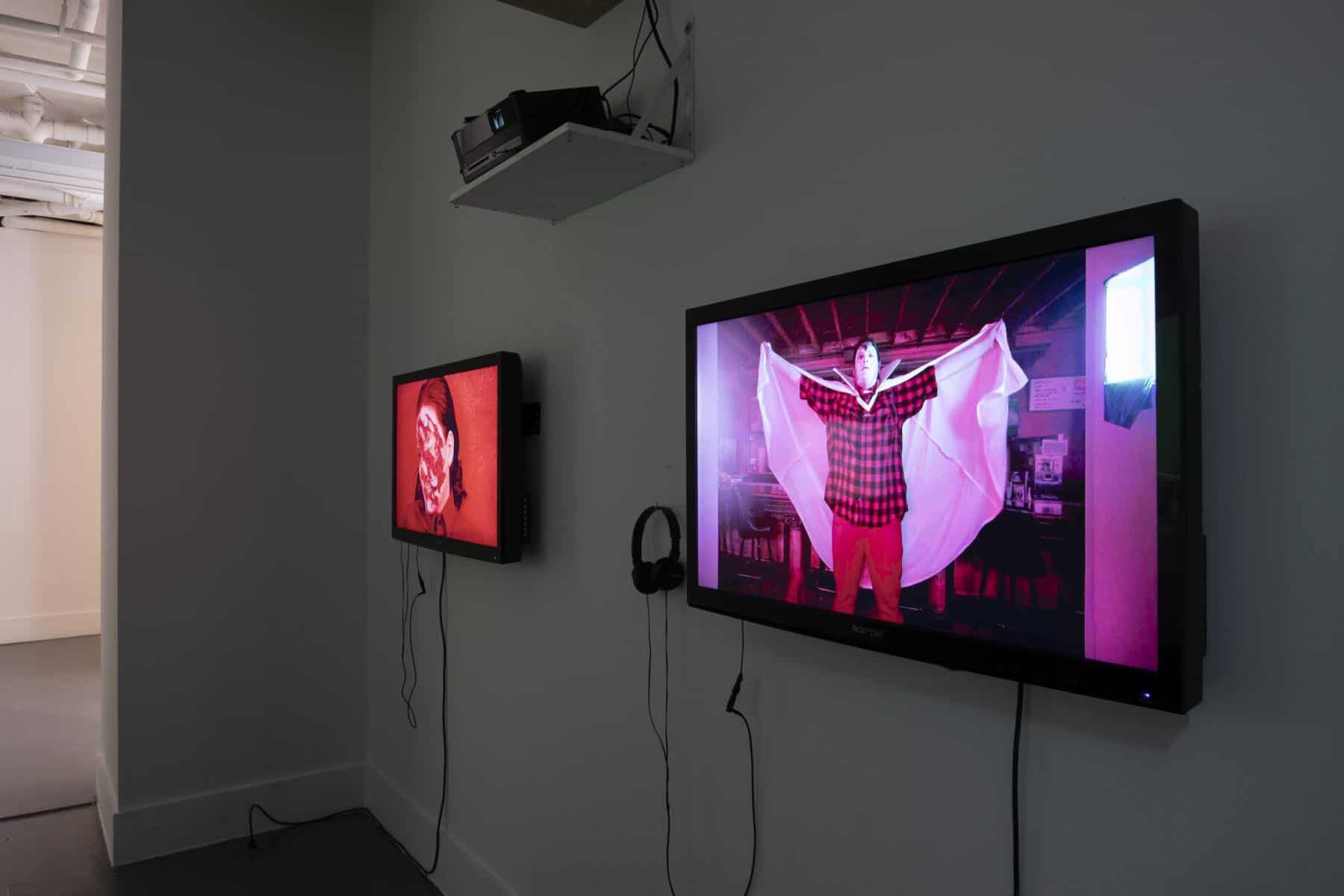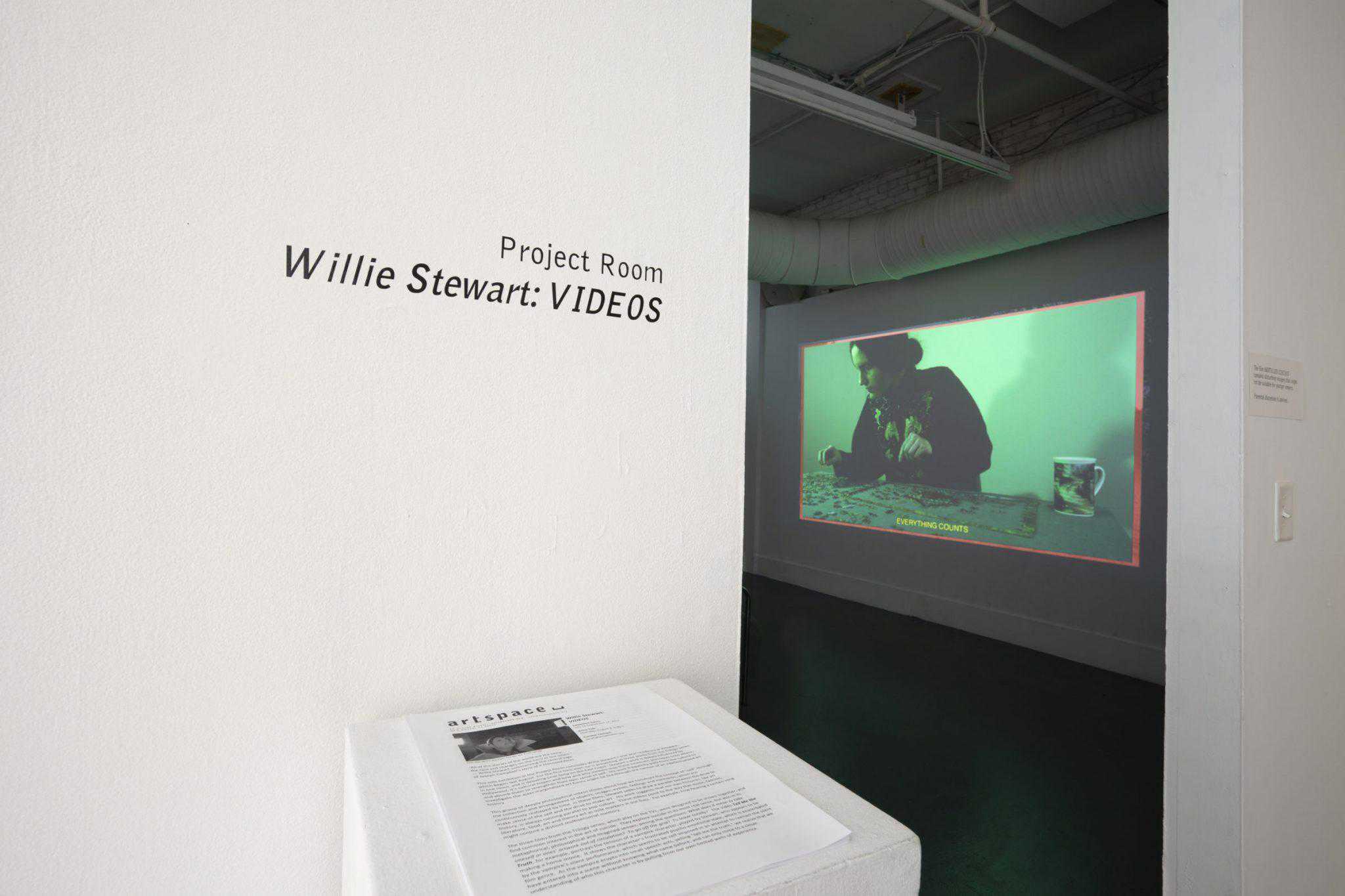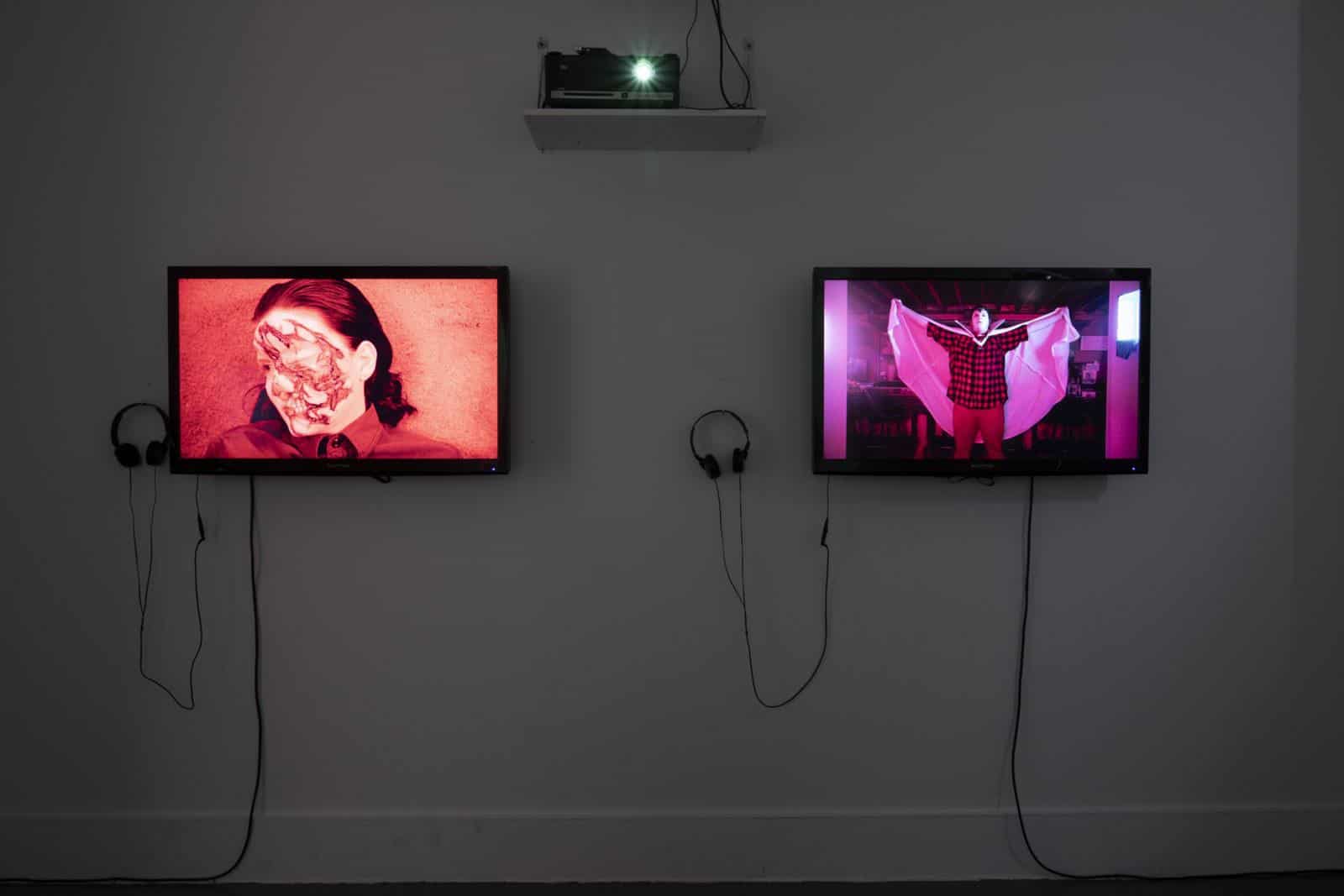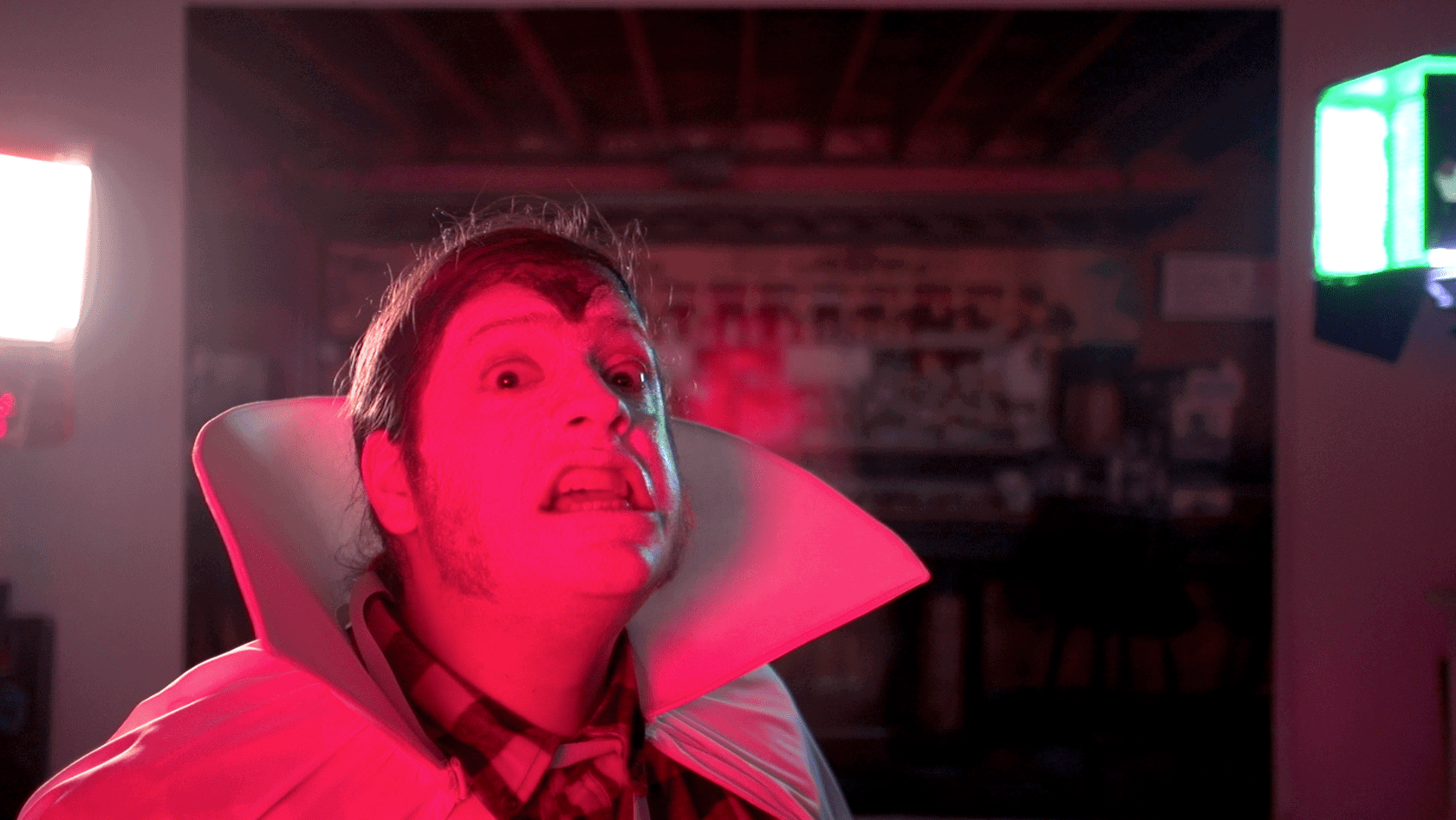
Willie Stewart: VIDEOS
July 26—September 14, 2019
installation view “Willie Stewart: VIDEOS”, 2019. Photo credit Jessica Smolinski.
— Willie Stewart summarizing the central logic of Joseph Campbell’s Hero of a thousand faces
This solo exhibition in the Project Room concludes Willie Stewart’s one year residency at Artspace, which began last August. For the first time ever, he is presenting all three works from the Trilogy series in one room, and is debuting Love Song on the East Coast. Stewart’s work is deeply influenced by Hollywood, it’s cultural tropes and how and why viewers map these cinematic portrayals onto others, and absorb them to strengthen their own sense of self. His work frequently pulls from low culture to investigate the ways marginalized art forms might be fed through the cannon of an intellectualized art history.
This group of deeply philosophical videos thinks about how we construct the concept of “self” through the collection and arrangement of objects, images, events, feelings and memories, which are continuously reshaped by time. In these films, Stewart seeks to draw a parallel between the drive to make sense of the self and the drive to make art. His work suggests that our own histories, like art history, is always running parallel to pop culture. These videos point to the way that music, fashion, literature, food, art and theory act as mile markers in our lives. For example, how hearing a certain song might conjure a distinct multisensorial memory.
The three films from the Trilogy series, which play on the TVs, were designed to be shown together, and find common interest in the act of suicide. They explore suicide in its most real sense, but also in its metaphorical, philosophical and imagined senses, posing the questions: What does it mean to take oneself or ones’ artwork out of circulation? To go off the grid? To leave totally? The video Tell Me the Truth, for example, portrays the tension of a vampire character, played by Stewart, who appears to be making a home movie. It shows the character’s frustrated psycho-emotional state, which is exacerbated by the vampire’s silent performance, which seems to be self-imposed in an attempt to reenact the silent film genre. As the vampire erupts into small speech acts, yelling “tell me the truth,” we realize that we have entered into a scene without knowing what came before, and can only come to a closer understanding of who this character is by pulling from our own limited wells of experience.
The second film, Noitulos Edicius, depicts a werewolf who lives underground bunker. He stares at his face in the mirror and plays a record that does not omit sound. The werewolf commits suicide twice, coming back to life after the first action. The film’s title prepares us for this looping and disturbing content, as the term Noitulos references a spiraling chambered shell, and Edicius, “suicide” spelled backwards, is a name that represents a restless coming back for more, even after death.
The third film, A Soundtrack to Disappear to and a Background to Do It in is the most minimal of the works and might be described as an endurance piece. It loops the same 5-minute segment of nature footage 10 times. The film is silent and overlaid with the lyrics of 10 popular songs about suicide, including Blue Moon, Everybody Hurts and Know It’s Over. The work pushes us to think about the way we find comfort in these songs, without giving us the pleasure of listening to the soundtracks that we know so well.
The video Love Song, which is projected on the main wall, probes the relationship between realism and abstraction. It largely consists of three tableaus, each depicting a lone character whose actions are cast in heightened sensual states of primary colors. A haunting and awe-inspiring musical score plays in the background as subtitles recite excerpts from Josef Albers’ teachings on color theory. Albers’ text guides us to see what Stewart wants from his viewers—to see how people, like colors, in their moments of contact and overlap, are read in relation to one another. In final moments, the subtitle, poetically authored by Stewart, reads THE ABSTRACTION IS REAL, MORE REAL THAN NATURE, LIKE A LOVE SONG. Like Trilogy, this film suggests that our feelings, and what we know to be our reality, is expressive, infinite and non-linear.
Bio
Willie Stewart is a mixed media artist whose work investigates memories, both personal and cultural, through different perceptions of time. He embraces sentimentality, fixing instants between two points – a beginning and an end. His works explore how we regard and arrange time, where we place longing, and what reminiscence looks like. Many of his pieces feature a layering or nesting of images, referencing the logic by which we organize our memories and the objects we collect. After receiving his BFA from Cooper Union in 2016, and his MFA in Sculpture from Yale University in 2018, Stewart joined Artspace as one of their 2018-2019 Artists-in-Residence. His work has been included in exhibitions at Soft Opening, London, UK; Seed Space, Nashville, TN; Boston Center for the Arts, Boston, MA; and Herron School of Art and Design, Indianapolis, IN. Ten new large paintings, which he created during his time in residence at Artspace, were recently featured in his debut solo show at Morán Morán Gallery in Los Angeles, and are reviewed in the Summer 2019 edition of Art Forum.
Exhibition Checklist
- NOITULOS EDICIUS (from the Trilogy series),2017, Running time: 3 minutes, 10 seconds, 4K digital video with stereo sound
- Tell Me the Truth (from the Trilogy series), 2018, Running time: 23 minutes, 52 seconds, 1080p digital video with stereo sound
- A Soundtrack to Disappear to and a Background to Do It in (from the Trilogy series), 2018, Running time: 39 minutes, 29 seconds, Silent 1080p digital video
- Love Song, 2019, Running time: 9 minutes, 29 seconds, 1080p digital video with stereo sound







